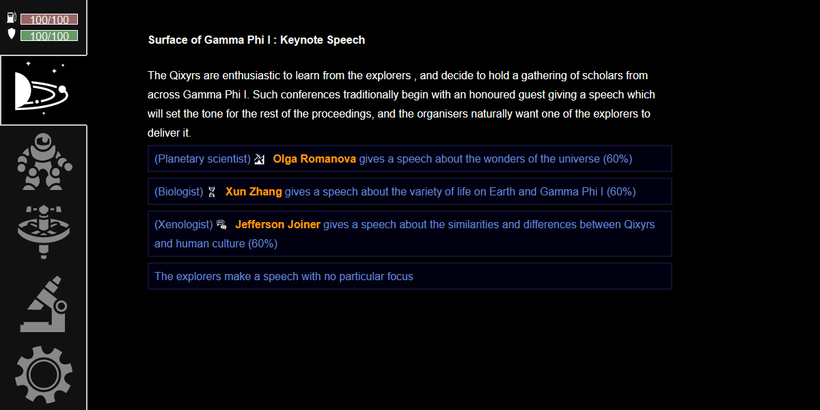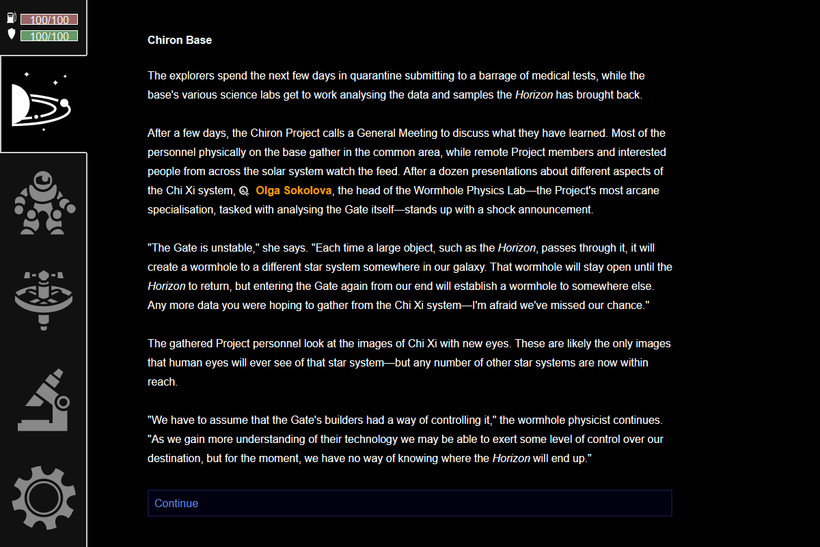I’ve made steady progress on Beyond the Chiron Gate this month, completing the first two steps of the development road map I set out in my last dev blog.
- Refactored and rearranged the code to make it easier to work with and remove dead code.
- Gone through the existing content, filling in placeholder text and removing or changing anything that didn’t work with the current game systems.
Here’s some screenshots of text I’ve filled in:



Some of the passages I’ve written this month include events taking place on Chiron Base, so I’ve had to finalise some of my thoughts about the future setting that the game’s space explorers call home. Since there isn’t much new game stuff to talk about this month, for this dev blog I’m going to go off on a tangent and talk about the future setting of Beyond the Chiron Gate.
A Hopeful Future
I’ve decided to go with an optimistic vision of the future, for a few different reasons. I want Chiron Gate to have a light, hopeful feel to it, and dropping hints about a dystopian future back home would jar with that. I want it to be about exploring the universe for the sake of scientific exploration, not military conquest or economic exploitation, and that requires a setting in which conquest and exploitation are no longer the driving forces behind exploration.
I also think that while sf works depicting dystopian futures are important as warnings, optimistic works are also important as sources of hope. A better future doesn’t seem likely at the moment, but seeing depictions of better worlds can help us believe that they’re possible, and that can help us build one. I’m probably overestimating my little game’s potential to contribute to the zeitgeist here, but it’s something I’ve been thinking about.
By telling a space exploration story with an optimistic setting, I’m obviously treading in the footsteps of Star Trek. As followers who’ve seen my occasional Twitter rants know, however, I don’t think Star Trek‘s worldbuilding is convincing or coherent; it tells us it has a utopian future, but the future it shows us mostly looks like the present day with flashier tech. I believe that a real post-scarcity, post-money future is possible, but I also think that it would look more different from the present day than Star Trek‘s does.
So, even though I’m only planning to drop hints about it in the game, I want to have a clear idea of what the future world of Beyond the Chiron Gate looks like.
Information Age Post-Scarcity Utopia on Planet Earth
The current intro text of Chiron Gate places the game in the middle of the 23rd century, which is far enough in the future for interplanetary travel to have become routine, but close enough to our time that the language and culture is recognisably similar to ours. (But not the same–as different from the present day as the present day is from the 1750s.)
At some point between now and then, the current world order of capitalism and nation-states has collapsed and been replaced by a digitally-enabled global direct democracy and a post-scarcity money-less economy. There wasn’t a single neat transition event, but a series of revolutions, reforms, and a process like the one depicted in Cory Doctorow’s Walkaway, in which people simply stop engaging with the current system and build something else in parallel.
By the 23rd century, everyone has a “fabricator”, a descendant of our 3D-printers, that can be fed raw materials and make most material goods people need. Each household has at least a general fab and a food fab, and there are other specialised types. The general fab is fed trash; the food fab is fed waste and whatever plants you can grow in your garden. One thing that a general fab can do is make the easy-to-assemble parts to make a new fabricator, which means that the system is decentralised: there’s no company or other entity you have to get your fabricator from, you can get one from your neighbour. (In the game, some of the events’ text refers to the spaceship having a general fabricator and a separate medical fabricator.)
For things that the automatic fabricators can’t make, people club together to help one another out. Construction projects would be an example: if someone needs to build a new house, a fabricator could produce the building materials, but everyone in the community would come together to assemble them. For people without helpful neighbours, or in the case of disasters where large numbers of people need help, there are institutions to organise volunteers from further afield.
People have plenty of time to help one another out because jobs in the modern-day sense are thing of the past. With your survival needs met by the fabricators and by your helpful neighbours, your boss can no longer hold the threat of starvation over your head to make you work at some bullshit job that doesn’t help you or your community but only enriches some capitalist. People can instead spend their time doing things that they enjoy doing and/or that will enrich their own and other’s lives.
Climate Change and Transition
Back to future history. The transition from capitalist nation states to the post-scarcity global democracy coincided with (and was in part caused by) anthropogenic climate change. Once the generations moved around so that the super-rich would see severe effects in their own lifetimes, and public pressure on governments became too heavy for even their future-tech-supported riot police to put down, governments and corporations finally sponsored a rapid shift towards renewable energy. That slowed the crisis down, but by then it was too late to stop it.
There were wars over scarce resources, and climate refugees dying at the borders of increasingly xenophobic first-world nations. But this is an optimistic vision of the future, so those forces were ultimately defeated by networks of people self-organising to help one another out and solve problems–with the help of state institutions where possible, and in spite of them when necessary. This self-organising network eventually coalesced into the global direct democracy that became the planet’s de facto government when the old nation states destroyed one another or withered away.
The first massive projects of the new global democracy were geo-engineering projects to keep Earth habitable in the face of climate change. Carbon was captured from the atmosphere; sea-walls were built; forests were planted. Many of the heavy industries that were still necessary were moved to orbit to protect the Earth’s surface from their effects, which was the initial reason for the post-capitalist society’s expansion into space. Some of techniques they developed to live on an increasingly hostile Earth could also be adapted to living on other planets, and people eventually set up scientific bases on the Moon, Mars, asteroids, and several of the moons of Jupiter, some of which grew into permanent colonies.
Non-Hierarchical Structures
The social structures of the 23rd century are generally non-hierarchical. On a small scale, people are organised into households (often but not always extended families), which make decisions collectively. On a larger scale, people organise themselves into groups based on geography and interest, and these groups use a form of digitally-enabled consensus decision-making which has been refined over the last two centuries. The consensus decision-making calls for facilitators, but actual leadership positions are created only when necessary and are not permanent.
Without employers or companies, people organise their activities with Societies (groups of people with a shared interest) and Projects (groups of people with a shared goal). I mention both in the opening text of the game: the Chiron Gate is detected by the Global Astronomical Society, which then sets up the Chiron Project to investigate it.
In the game, the Chiron Project is an assembly of volunteers who organise themselves using collective decision-making. They collectively select the crew of the ship, who then collectively make decisions about how to react to what they find beyond the Gate. This is why none of the explorers is the ship’s commanding officer, and why I don’t identify an overall head of the Chiron Project. (This is actually a difficult mindset to get into for someone who grew up in hierarchical systems. While I was writing this I noticed that in one the screenshots above I’d introduced a particular character as the head of of one of the Chiron Project’s departments, so I’ve just changed them to be the spokesperson for that department.)
I don’t know whether such absolutely non-hierarchical structures are really plausible, especially when split-second decisions might need to be made on a spaceship, but I’ve decided to go all-in on this element of the setting because I think it’s interesting, and will make the game different from things like Star Trek with their military organisations.
This also neatly explains who “you” are in the game. You’re playing as the consensus decision-making process of the ship’s crew (when on a mission) or the Chiron Project (when at the base). Whatever you pick is what the group decides.
*
Overall I don’t know how plausible this vision of the future is. It’s what suits the story rather than what I think is most likely (in particular I don’t think a post-scarcity society would have much reason to colonise the solar system, but my premise kind of requires space travel to be commonplace). I also don’t think what I’ve described is a perfect world, although it is a better one. People still have problems, but their problems generally occupy the top half of Maslow’s Hierarchy of Needs rather than the bottom half.
Most of this detail won’t make it into the game anyway, except as hints, but working it all out like this will help me to keep the hints self-consistent.
Anyway, thanks for indulging this digression, if you’ve made it this far. Next month I should hopefully have some shiny new features to show off.
